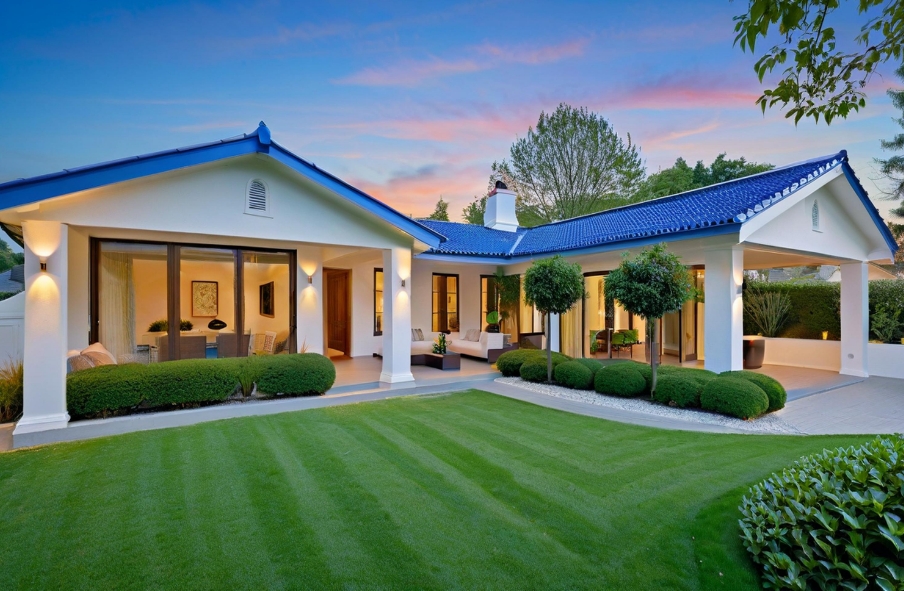Detailed explanation of light steel structure residential system
Detailed explanation of light steel structure residential system
I. Overview
1. Basic features
The house building system is made of cold-bent thin-walled steel components as the basic structural skeleton, new structural plates as the structural system, and other insulation and decorative materials, which are integrated and produced in the factory and assembled on site. This system adopts a cold-bent thin-walled steel structure system, which has the characteristics of small cross-sectional size and light weight. It increases the use area of traditional buildings by 5-10%, significantly reducing the foundation cost; the unique wall load-bearing system makes the building shape light and dynamic, and improves the flexibility of the interior layout; low-carbon and environmentally friendly building materials make the building more durable and safer in structure, with good earthquake resistance, fire resistance, thermal engineering, and sound insulation performance. It is an efficient and energy-saving green building system.

2. Scope of application
The ultra-light steel residential system is suitable for new, rebuilt, and expanded buildings with 1 to 6 floors (excluding basements, and the eaves height should not exceed 12m). However, the number of floors of mixed structure buildings with cold-bent thin-walled steel skeletons and steel structures and reinforced concrete structures is not limited by this.
2. Performance indicators
Durability: more than 70 years of service life;
Snow resistance: basic snow pressure of 1.55kN/㎡;
Seismic resistance: 9-degree fortification (basic earthquake acceleration 0.4g);
Wind resistance: basic wind pressure of 0.85kN/㎡, wind speed of 209km/hr
Sound insulation performance: the sound insulation of the exterior wall (200mm thick wall) is 65dB, and the sound insulation of the interior wall (double-sided double-layer 9.5mm gypsum board, 181mm wall) is 44dB;
Ventilation performance: natural ventilation and air supply are combined to ensure fresh and clean indoor air, and the fresh air volume is greater than 15%;
Exterior wall impact resistance: 250kg concentrated impact load;
Thermal insulation performance: the thermal resistance value of the 200mm thick wall is 4.24K•㎡/W, and its thermal insulation performance is twice that of the 490mm thick porous block brick.
3. Normative reference documents
The following standard articles are mainly cited. When the standard is revised, the latest version of the reference standard is used:
《Building Structure Load Code》GB50009-2012
《Concrete Structure Design Code》GB50010-2010
《Building Seismic Design Code》GBSOOll-2010
《Building Design Fire Protection Code》GB50016-2014
《Steel Structure Design Code》GB50017-2003
《Cold-bent Thin-walled Steel Structure Design Code》GB50018-2002
《Building Structure Reliability Design Unified Standard》GB50068-2001
《Low-rise Cold-bent Thin-walled Steel Structure Design Code》GB50018-2002
《Building Structure Reliability Design Unified Standard》GB50068-2001
《Low-rise Cold-bent Thin-walled Steel Structure Design Code》GB50017-2003
《Steel Structure Design Code》GB50018-2002
《Building Structure Reliability Design Unified Standard》GB50068-2001
《Low-rise Cold-bent Thin-walled Steel ...10-2001
《Building Structure Reliability Design Unified Standard》GB50010-2001
《Building Structure Reliability Design Unified Standard》GB50010-2001
《Building Structure Reliability Design Unified Standard》GB50010-2001
"Technical Code for Building Construction of Thin-walled Steel Structures" JGJ227-2011
"Fiber Cement Flat Plate" JC/T412.1-2006
"Fiber Reinforced Calcium Silicate Board" JC/T564.1-2008
"Code for Acceptance of Construction Quality of Steel Structure Project" GB50205-2001
"Carbon Structural Steel" GB/T700-2006
"Technical Conditions for Cold-bent Steel" GB6725-2008
"Low-alloy High-strength Structural Steel" GB/T1591-2008
"Standard for Quality Inspection and Assessment of Steel Structure Project" GB50221-2001
Other relevant professional technical specifications and regulations currently in force in other countries or industries.
4. Seven advantages of light steel residential system
1. Safety
Compared with wooden structures, steel structures have much better fire resistance and termite resistance than wooden structures. The emergence and development of ultra-light steel structure buildings in North America is largely due to the poor fire resistance and termite resistance of wood structures themselves. Therefore, ultra-light steel structure systems were developed based on light wood structures.
Compared with traditional brick-concrete structures, steel structure systems themselves are more ductile and elastic than brick-concrete structures. Ultra-light steel structures belong to plate-rib structure systems. They are composed of walls and floors formed by light steel keels and European pine boards as load-bearing structures. They belong to super-static structure systems. The destruction of a single light steel keel or European pine board will not immediately lead to the destruction of the overall structure, which is conducive to the escape of people in the building.
At the same time, steel structure buildings with light weight are more conducive to resisting horizontal loads during earthquakes (horizontal loads are the product of the building's own weight and horizontal acceleration. The smaller the mass of the building, the smaller the horizontal load it bears). Therefore, in earthquake-prone areas such as Japan and Taiwan, low-rise buildings are mostly light wood and steel structures with light weight.
2. Convenience
Compared with traditional brick-concrete structures, the transportation volume of steel structure buildings with light weight is less than that of brick-concrete structures. It is conducive to construction in areas with inconvenient transportation, such as islands and mountainous areas. Ultra-light steel buildings can also complete some assembly tasks in the factory according to the needs of the project to form a whole wall and floor, reduce the amount of on-site work, speed up on-site installation, and are suitable for projects with poor local construction conditions and short construction periods.
3. Environmental protection
The building materials used in the light steel residential system products are all green and environmentally friendly materials that meet national standards. The light steel keels used can still be recycled after 70 years. A large number of finished components are used for installation during on-site construction, and the demand for construction water is small. The entire construction process greatly reduces the discharge of wastewater, waste dust and solid waste compared to brick-concrete structures, which is beneficial to the protection of the local environment. During the construction of the light steel residential system, material loss is reduced by 60%, on-site garbage is reduced by 80%, recyclable materials account for 80%, and building energy saving is increased by 50%.
4. Energy saving
The exterior wall of the light steel residential system adopts a double-layer insulation structure, which is from the inside to the outside: gypsum board, light steel keel, R19 centrifugal glass fiber wool, OSB (European pine board), breathing paper, extruded board and exterior wall finishing layer. Since the wall uses R19 centrifugal glass fiber wool and 25mm thick extruded board double-layer insulation materials, the thermal resistance of the wall system can reach 4.24K•㎡/W, and its thermal insulation performance is twice that of a 490mm thick porous block brick wall.
The building roof from the inside to the outside is: gypsum board, R30 centrifugal glass fiber wool, light steel keel, OSB (European pine board), waterproof membrane and roof decoration layer. The eaves board is a porous structure, which makes the entire roof truss ventilated and breathable. The circulating air can prevent mildew and also play a role in thermal insulation. The thermal resistance of the entire roof system is 5.284K•㎡/W, which is 75 times that of an ordinary 120mm thick concrete roof (thermal resistance is 0.07K•㎡/W).
5. Practical
The thickness of the double-layer insulation decoration exterior wall of the light steel residential system is only 180mm, which is 60mm smaller than the brick-concrete structure wall without insulation decoration (generally 240mm).
According to the project calculation, the house rate of the light steel residential system is 5%-10% higher than that of the ordinary brick-concrete structure. At the same time, since the light steel structure system uses wall panels and floor slabs instead of traditional beams and columns, there are almost no beams and columns in the interior of the light steel building, and the space utilization is higher.
6. Fast
The light steel residential system uses factory-processed components, assembled on-site, and does not require maintenance, so the construction speed is 30%-50% higher than that of ordinary brick-concrete structures. The entire construction process is divided into eight steps: foundation construction, wall installation, roof installation, structural sealing, exterior wall insulation, interior decoration, outdoor decoration and completion and delivery. The construction period of rough houses without foundation construction is 1-2 months, and the construction period of finely decorated houses is 2-3 months.
The installation time of a 100-square-meter ultra-light steel main structure is only 4-5 days, and the overall construction period is at least 1/2 of the time of traditional buildings.
7. Good comprehensive economic benefits
A. Short construction period, early production and early benefits;
B. Increased effective use area;
C. Reasonable allocation of investment and use, and the price is worth it; the allocation of ground and underground engineering costs is 90:10;
D. The allocation of materials and labor costs is 60:40;
Therefore, the comprehensive economic benefits of the light steel residential system are better than those of reinforced concrete structures.
V. Construction Methods
1. The schematic diagram of the structural system is as follows:
2. The schematic diagram of the floor structure system is as follows:
3. The schematic diagram of the wall structure system is as follows:
4. The schematic diagram of the roof structure system is as follows:
VI. Performance of the main structure of ultra-light steel
1. Selection of steel
The cold-bent thin-walled steel used for the load-bearing structure of low-rise cold-bent thin-walled steel houses should adopt Q235 and Q345 specified in the current national standards "Carbon Structural Steel" GB/T700 and "Low-alloy High-strength Structural Steel" GB/T1591, as well as Q550 grade steel that meets the requirements of the current national standards "Continuous Hot-dip Galvanized Steel Plate and Steel Strip" GB/T 2518 and "Continuous Hot-dip Aluminum-zinc Alloy Coated Steel Plate and Steel Strip" GB/T14978.
2. Structural Performance
The strength design value of cold-bent thin-walled steel should be adopted according to the following table.
Design value of cold-bent thin-walled steel strength (N/mm²)
Steel grade
Steel thickness
t (mm)
Yield strength
fy
Tensile, compressive and bending resistance
f
Shear resistance
fv
End face pressure (ground flat and tightened)
fe
Q235 steel
t≤6.0
235
205
120
310
Q345 steel
t≤6.0
345
300
175
400
Q550 steel
t≤0.6
585
500
285
—
0.6<t≤0.9
550
470
270
0.9<t≤1.2
515
440
250
1.2<t≤1.5
465
400
230
3. Requirements for galvanizing
The minimum coating requirement is to protect the steel from corrosion, and the thickness of the galvanizing layer is used according to the design requirements. Common galvanizing requirements are shown in the table below.
Minimum galvanizing requirements (g/㎡)
Regional categories
Minimum galvanizing requirements
General areas
180
Coastal areas, highly corrosive areas
275
4. Corrosion resistance of steel
Depending on the environment of the building construction site, the requirements for galvanizing of steel sections are also different. The amount of zinc layer determines the service life of the building structure. At present, the standards of various countries are basically divided into three levels:
1) When the components are in a humid environment and exposed, the galvanizing amount is required to be 275 grams/m² (equivalent to a galvanizing thickness of 20 microns);
2) For load-bearing and exterior wall components, the galvanizing amount is required to be 180 grams/m² (equivalent to a galvanizing thickness of 13 microns);
3) For non-load-bearing components, the galvanizing amount is required to be 120 grams/m² (equivalent to a galvanizing thickness of 8 microns);
According to the British Steel Company's follow-up sampling test results of 15 light steel houses in different regions and environments:
The corrosion rate of light steel galvanized components is less than 0.1 microns on average in three years, that is, the service life of 8-micron thick galvanized cold-bent thin-walled steel components can reach 240 years under normal use conditions. The design life of general houses is only 60 years;
The National Housing Research Center NAHB of the United States conducted a follow-up sampling test on 4 light steel houses located in cold or hot coastal areas with poor environment. The results show that the service life of the light steel galvanized components currently used in the houses can reach more than 100 years;
The hanging test of China Second Automobile Works showed that the five-year corrosion depth in dry and non-corrosive medium conditions in Shiyan, Lanzhou, Guilin, Kunming and other places is 0.00327.
VII. Characteristics of ultra-light steel main structure components
VIII. Packing method of ultra-light steel main structure components
We pack the house components (such as walls and roof trusses) for easy identification and convenient loading and unloading.
9. Ultra-light steel main structure installation steps
Step 1: Assemble the components according to the drawings of each component, and then connect them into a whole with self-tapping screws
Step 2: Put the assembled components in the designated position according to the foundation layout, and fix them with temporary supports
Step 3: Recheck the size and correct the keel
Step 4: Connect the wall to the foundation after adjusting the wall position, and connect the components to each other
Step 5: Install other accessories such as wall wind-resistant pull belts and tensioners
Step 6: Install the roof truss/floor, and it's done
Description: For multi-story houses, after installing the floor frame, install the floor structure board and fix the first layer of wall structure board, and then install the second-layer frame according to the first step.
10. Construction process
1. The foundation construction process includes:
Measurement and layout → Foundation inspection trench → Pipeline pre-embedding → Pad pouring → Rebar binding → Formwork construction → Concealed acceptance → Foundation pouring → Formwork removal → Foundation acceptance → Foundation axis layout.
2. The construction process of the wall system includes:
Wall measurement and layout → Wall frame assembly (if the wall is assembled in the factory, this step is completed in the factory) → Waterproof and moisture-proof membrane (pad) laying → Single wall frame installation → Temporary diagonal bracing construction → Wall correction → Connection between walls → External wall X shear steel belt construction → Wall re-inspection → Wall pull-out and shear anchor bolts and foundation connection → Wall panel (OSB board) installation → (Water and electricity pipeline installation → Filling insulation cotton → Inner wall panel (gypsum board)) → Breathing paper installation → Insulation board installation → Brushing interface agent → Mesh cloth or wire mesh → Mortar → Decorative layer.
Picture 3. The construction process of the floor system includes:
Floor measurement and layout → Floor side rail installation → Floor beam installation → Beam end web stiffener and stiffening short column setting → Floor support system installation → Double-sided tape (3mm foam glue) on the floor beam → Floor panel (OSB panel) installation → 40 thick fine stone concrete (with wire mesh inside) pouring → (Water and electricity pipeline installation → Filling insulation cotton → Ceiling board (gypsum board)) → Decorative surface layer.
4. The construction process of the roof system includes:
Truss measurement and layout → Truss and wall connector installation → Truss installation → Correction → Setting the roof support system → Small ridge board and eaves installation → Roof panel installation → Large ridge board installation → Waterproof membrane laying → (Water and electricity pipeline installation → Filling insulation cotton → Ceiling board (gypsum board)) → Roof tile installation.


